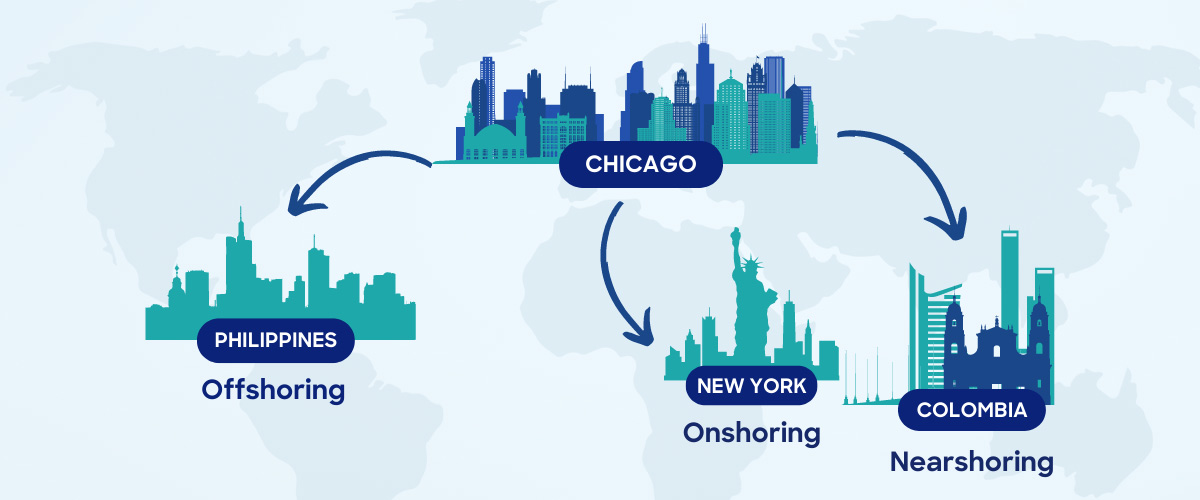Nearshoring: Is it the right solution for your business?
What is nearshoring
Having constant access to quality talent is vital to sustaining the growth of your business. But local talent pools can be quite limited, especially if you work in an industry with fast-rising demand for skilled labour. So, it makes perfect sense for business owners to tap into other, more-readily available talent markets nearshore.
Nearshoring is a business solution that allows you to access talent from a neighbouring country through a third-party provider operating in that location, typically in a place where there are little to no time zone differences and with similar cultures and languages.
Countries that have nearshore capabilities usually have lower labour costs compared with your local talent market. This makes nearshoring a compelling go-to strategy for businesses that are looking for cost-cutting solutions.
If you are in the United States, for example, nearshoring providers in Colombia can help you look for skilled and experienced professionals within Latin America, a region that is teeming with talent in various fields, including technology, finance, human resource and more.
Even businesses in the United Kingdom can rely on nearshoring providers in English-speaking regions across Southeastern Europe, a relatively untapped talent market that can deliver in the most in-demand industries in the continent.
Nearshoring vs onshoring vs offshoring
Nearshoring, onshoring, and offshoring are all forms of outsourcing, where you assign certain business functions that you typically have in-house to a third-party provider, usually for cost-efficiency and other strategic goals.
The difference, as the prefixes show, is in the location where talent is soured: Onshoring means outsourcing to providers in your country, nearshoring means outsourcing to a different country within the same region, while offshoring means outsourcing to a country on the other side of the world.
READ MORE: Outsourcing vs. subcontracting: Are they the same?
READ MORE: Outsourcing vs offshoring: Are they truly different?
Your business can benefit from nearshoring, onshoring, or offshoring, depending on the pain points that you need to resolve. That’s why you need to be clear with your goals and timelines before you go into outsourcing.
For example, if you are looking for a dedicated customer service team that can work within your local hours, then it might be better to look at the nearshore market than offshore, where people work in a completely different time zone.
But if you are looking to maximise cost savings, you can still look for talent offshore that can adapt to your preferred schedule because the offshore talent market offers considerably lower costs compared to its onshore and nearshore counterparts.
Weighing the pros and cons of nearshoring
The Pros
· Visiting your team is easier and less expensive – Due to the proximity of nearshoring sites, companies can visit their teams more frequently to nourish closer ties. The firm’s headquarters can also invite the nearshoring team to welcome them and build rapport.
· Better communication – Skilled talents in nearshoring sites are more likely to speak the same language, which will facilitate quicker, simpler, and more efficient communication. It is also likely that they have similar cultures and values, which makes work a whole lot easier.
· Improved collaboration – Nearshoring allows for better collaboration as team members are likely to work within or near the same time zone. Time differences and distance are no longer a hindrance to joint projects.
· Minimal logistical disruptions – If and when supplies are necessary, it is easier to transport these to the nearshoring site with little to no tariffs. This also allows for faster transportation from, say, the production site to the client.
· Lower costs than onshoring – Nearshore talent markets often have lower costs of living, and more competitive tax and financial incentives compared to your country of origin. This will allow you to reallocate your spending on improving other high-value services.
· Instant business continuity – In the event of an emergency or a disaster, having a nearshoring team in place makes it easier to plan and execute protocols and operations for business continuity.
The Cons
· Slightly higher costs compared to offshoring – Compared to countries in other parts of the globe, the cost of labour and living in nearshore markets and your country of origin are almost the same. So, expect slightly higher costs if you’re used to the pricing of offshore outsourcing.
· Talent pools can be limited depending on region – Without question, there are untapped talent markets nearshore. But going offshore is still the way to go if you want to access a larger, more diverse talent pool.
· Missing out on 24/7 capabilities – If you need a 24/7-capable workforce, nearshoring might not be the best answer because talent in these regions operate within similar time zones. Offshore remote teams, however, can give you that capability and versatility.
Is nearshoring the right solution for your business?
Nearshoring is the best solution for your business if the need to build a dedicated team that has minimal language, cultural, and time zone barriers outweighs the need for huge cost savings that offshore solutions can readily provide.
Some companies also leverage nearshore solutions to reduce the impact of geopolitical and economic disruptions. Having separate teams nearshore and offshore will ensure your operations stay seamless when political tensions or economic dips arise.
Nearshoring will also strengthen the resilience of your business when it comes to supply chain disruptions, which can be a result of global political tensions between major countries like the US, UK, Russia, and China.
Compared to having an offshore team, visiting your nearshore team is faster and more convenient. With just a quick 1-hour or even a 4-hour flight, you could be on the ground with your staff for work or face-to-face catchups. If you want to visit your team often without spending a lot of time and resources, then nearshoring can be the best solution.
The key to getting the most out of nearshoring is to be clear and specific about the goals you want to achieve. Next, look for a provider that can deliver the exact results you need. Always insist on partners that can offer flexible and tailor-fit solutions to your pain points.
Finally, opt for vendors that can deliver measurable results, give you firm and total control of your team, provide transparent costings, and guarantee your participation in all phases of the partnership. After all, it wouldn’t be a partnership if you’re left out of the process, would it?














